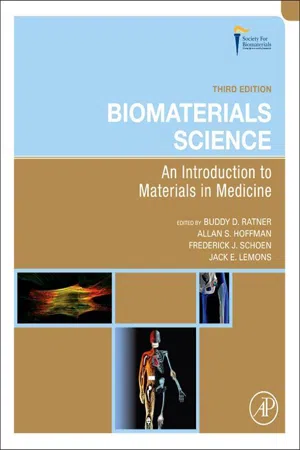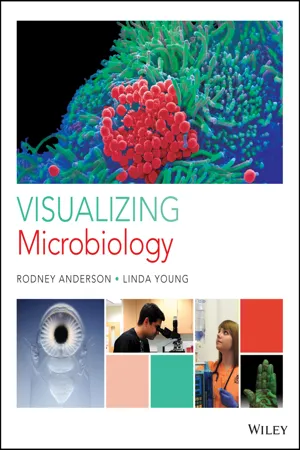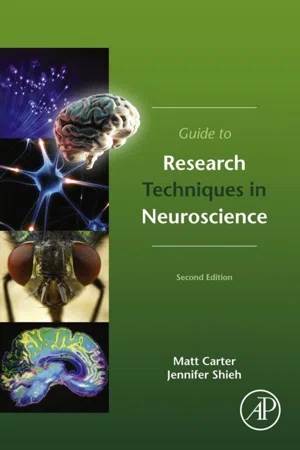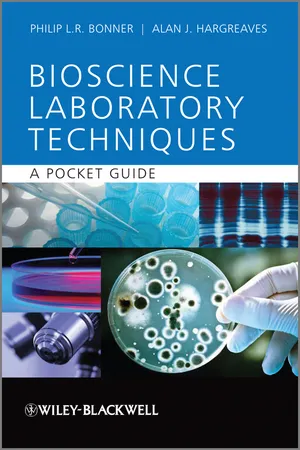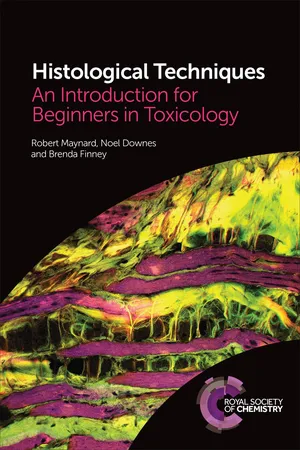Biological Sciences
Microscopes
Microscopes are essential tools used to observe and study biological specimens at the cellular and molecular levels. They work by magnifying the image of tiny objects, allowing scientists to see details that are not visible to the naked eye. There are different types of microscopes, such as light microscopes and electron microscopes, each with its own specific applications and advantages.
Written by Perlego with AI-assistance
Related key terms
Related key terms
1 of 4
Related key terms
1 of 3
10 Key excerpts on "Microscopes"
- eBook - ePub
Biomaterials Science
An Introduction to Materials in Medicine
- Buddy D. Ratner, Allan S. Hoffman, Frederick J. Schoen, Jack E. Lemons(Authors)
- 2012(Publication Date)
- Academic Press(Publisher)
Chapter II.3.8
Microscopy for Biomaterials Science
Kip D. Hauch1 and Buddy D. Ratner21 University of Washington, Seattle, WA, USA2 Professor, Bioengineering and Chemical Engineering, Director of University of Washington Engineered Biomaterials (UWEB), Seattle, WA, USAThe microscope is so widely used in all branches of science and technology that it is almost iconic of research or science. The scientist relies heavily on vision; thus the advent of the light microscope is among the earliest, and arguably most powerful, tools in the history of science. Today, microscopy in its various forms still remains as a pre-eminent tool at the forefront of scientific exploration. Thus, the biomaterials scientist makes extensive use of both light and electron Microscopes to help fabricate and characterize new materials, coatings, and devices, and to study the behavior of cells and tissues at the biomaterials interface. This chapter will familiarize the reader with the more common microscopy tools used in current biomaterials research. The key concepts of magnification, resolution, and contrast are first introduced and then their meaning explored in the context of light microscopy. Digital imaging is very briefly addressed. Attention then moves to the electron microscopies, specifically scanning electron microscopy (SEM). Finally, new developments in optical microscopy are addressed that are shattering limitations of microscopy that have inhibited progress for hundreds of years. Fortunately, the ubiquitous importance of microscopy in the practice of science means that there exist numerous excellent resources to consult on these topics. A brief guide to some useful resources is found at the end of the chapter.Magnification, Resolution, and Contrast
The art of scientific instrumentation is to devise tools to observe natural phenomena and present them appropriately to our senses for interpretation (e.g., to our eyes as an image). Three concepts apply to this process: magnification; resolution; and contrast. The three concepts are interdependent, and frequently limitations in one aspect or another leads to trade-offs. - eBook - ePub
- M Jaffe, W. Hammond, P Tolias, T Arinzeh(Authors)
- 2012(Publication Date)
- Woodhead Publishing(Publisher)
From the seventeenth century onward, imaging has been an important tool that has allowed the advancement of knowledge in the biological sciences. We can say it all started with Antonie van Leeuwenhoek, the Dutch lens maker and scientist, when he produced his early forerunners of the modern microscope. With his handcrafted Microscopes, van Leeuwenhoek was the first to observe and describe bacteria, muscle fibers, spermatozoa and blood flow in capillaries. His early studies also established imaging as a major research tool for the biomedical sciences. Today, with the melding of both biology and materials science to produce both natural and man-made bio-materials, imaging has become a major characterization technique to carry out the further development of these materials that will be implanted in the human body to perform, augment or replace natural bodily functions. Though there are many types of imaging used in the biomedical sciences, in this chapter imaging refers to observations and measurements carried out with Microscopes using light, electrons or scanned molecular mechanical probes.The following definitions for images, imaging and microscopy are presented in order to clarify imaging concepts that appear later in this chapter:Image – the optical counterpart of a self-luminous or illuminated object formed by the light rays that traverse an optical system made up of a series of lenses; each point of the object has a corresponding point in the image from which rays diverge or appear to diverge. This definition holds true for optical systems using illuminating beams other than light, such as electrons.Imaging – the formation of images of objects that can be created using light (optical microscopy), lasers (confocal microscopy), electrons (scanning and transmission electron microscopies) and scanned molecular mechanical probes (atomic force microscopy).Microscopy – the interpretive application of magnification created by a microscope to the study of materials that cannot be seen properly by the unaided eye.Microscopes do not only magnify objects. A more important measurable property of Microscopes is their capability to resolve or clearly determine two separate points, or objects, as singular, distinguished entities. This property is known as microscope resolution. The lower resolution limit of a microscope system decreases from microns to nanometers and angstroms as an analyst goes from producing images with light rays to producing them with electrons and scanned molecular mechanical probes. These image techniques are shown in Table 1.1 - eBook - ePub
- Rodney P. Anderson, Linda Young(Authors)
- 2016(Publication Date)
- Wiley(Publisher)
resolution.Magnification
Because by definition microorganisms are too small to see with our eyes alone, we must magnify them to view them. Light Microscopes use different types and numbers of lenses to produce a magnified image of the specimen. A compound light microscope (Figure 3.2a ) uses a condenser lens to focus light onto a specimen and the iris diaphragm adjusts the intensity of the light reaching it. Light passing through the glass microscope slide and thin specimen next enters an objective lens. The curvature of this lens bends, or refracts, the light, magnifying the specimen. A small mirror redirects the light through the ocular lens, where it again bends and magnifies the specimen before it is directed to the eye for image viewing.Microbiology InSight
Microscopes must both magnify a specimen and clearly resolve the image to be effective tools for a microbiologist.Using a compound light microscope • Figure 3.2a. A compound light microscope focuses light on the specimen through a condenser lens. Both the objective and ocular lenses magnify the specimen. An iris diaphragm, which has an opening of adjustable size, controls the light intensity.b. Magnification is determined by dividing the image size by the object size. Although these two images are a similar size, the deer tick has been magnified 9.6 times and the Paramecium has been magnified 110 times.c. - eBook - ePub
- Matt Carter, Jennifer C. Shieh(Authors)
- 2015(Publication Date)
- Academic Press(Publisher)
The first Microscopes were used in the seventeenth century to expose the microscopic world of cells and single-celled organisms. Scientific pioneers such as Robert Hooke and Anton von Leeuwenhoek, often called the fathers of microscopy, used homemade Microscopes to study cell types from a variety of living organisms. In the late nineteenth and early twentieth centuries, Santiago Ramón y Cajal used a microscope in combination with histology to produce highly detailed, seminal studies of nervous system structure.The microscope is now an indispensable tool in neuroscience. Because organelles, glial cells, neurons, and even populations of neurons cannot be seen by the naked eye, a microscope is essential for examining the nervous system at the cellular level. Light Microscopes can enlarge the image of an object up to 1000 times greater than normal, providing access to the structure of a cell and its local environment. Fluorescent Microscopes provide an even greater ability to highlight individual subcellular structures. Electron Microscopes can theoretically enlarge an image 1 million times greater than normal, providing unparalleled insight into the smallest neuronal structures including synapses, surface receptors, and even individual proteins.The goal of this chapter is to provide a fundamental understanding of common forms of microscopy. First, we define the fundamental parameters and parts of a light microscope. Next, we survey the different forms of microscopy and why an investigator might choose one form over another. Finally, we examine issues related to processing and interpreting microscopy data. The information in this chapter will complement information in many other chapters, especially methods in Chapters 6 and 7 used to investigate neural structure and function.Essential Principles of Microscopy
While modern Microscopes are undoubtedly more advanced than those used a few centuries ago, the fundamental parts of a microscope and the theory behind how they work together are essentially the same. Before surveying different forms of microscopy, we review the fundamental parameters and parts of standard light Microscopes. - No longer available |Learn more
Basic Bioscience Laboratory Techniques
A Pocket Guide
- Philip L.R. Bonner, Alan J. Hargreaves(Authors)
- 2011(Publication Date)
- Wiley(Publisher)
Ultrastructural detail of all the above macromolecular structures can be seen using transmission electron microscopy. Although structural detail of macro- molecules cannot be visualized directly in the light microscope, it is possible to demonstrate the location and distribution of many macromolecules within cells and tissues with the aid of histochemical staining (see later). In combination with biochemical sub-fractionation techniques, microscopy has played a central role in the study of cell structure and organelle function.Student exercise2.2 Microscopes – General Principles- Draw a labelled diagram of a typical animal cell, indicating the main structural components.
- List any additional structures that are absent from animal cells but present in (a) plant cells and (b) yeasts.
- Indicate which of the structures found in eukaryotic cells are absent from prokaryotes.
All Microscopes consist of a coordinated system of lenses providing a magnified image of the specimen. They are invaluable tools in the study of the structure, organization and migration of cultured animal and bacterial cells. Microscopy can also be used to determine tissue organization and the viability, distribution and function of cells within tissues as well as the identification, organization and quantification of organelles and macromolecules within cells and tissues. Microscopy therefore has applications in all of the bioscience related subjects including microbiology, cell biology, biochemistry, biomedical sciences, forensic science, pathology, toxicology, plant biology, and so on and is particularly useful at providing supporting data for molecular studies of cellular components.The type of microscope needed for a particular task depends on the level of detail required. The main differences between the different types of Microscopes are the wavelength of electromagnetic radiation (see Chapter 3) used to obtain the image, the nature and arrangement of the lenses and the methods used to view the image. In this chapter we will look at the principles of light and electron microscopy, but first of all we will consider some general principles applicable to all types of microscopy. - eBook - ePub
Histological Techniques
An Introduction for Beginners in Toxicology
- Robert Maynard, Noel Downes, Brenda Finney(Authors)
- 2015(Publication Date)
- Royal Society of Chemistry(Publisher)
CHAPTER 3
The Light Microscope
The light microscope is the essential tool of the histologist. All histologists need to know how to get the best from their microscope; this is not particularly difficult to achieve, especially if modern instruments are available. Despite this, many histologists show little interest in microscopy and put up with poor performance from their Microscopes. This poor performance can be corrected if the principles on which a microscope works are understood. In this chapter we start at the very beginning and develop the theory of the light microscope in easy stages. At every point, emphasis has been placed on practicality: how to use the microscope in addition to understanding how it works. Electron microscopy has not been included. This is because it involves techniques that are often beyond the reach of the beginner; whilst most biologists have access to their own light microscope, few, even now, have access to an electron microscope. Immunohistochemistry is considered in a later chapter of this book and a short description of the light microscope as adapted to take advantage of fluorescence as a means of identifying components of tissues and cells is included here.3.1 Introduction
The light microscope is perhaps the instrument most widely used in biological research; it is also, rather surprisingly, one of the least well understood by its users. Perhaps even more surprising is the fact that the majority of histologists and pathologists seem not very interested in microscopy.All biologists are familiar, to a greater or lesser extent, with the light microscope (hereafter referred to as the microscope): they may have been given one as a child; they will have used one in school and at university; and they may have used one in their research work. Modern Microscopes are easy to use and, unless the instrument is very badly adjusted or has become damaged in some way, the user will see something of the specimen being examined. An example of a high-quality standard microscope is shown in Figure 3.1 - eBook - ePub
- Jeremy Sanderson(Author)
- 2019(Publication Date)
- Wiley(Publisher)
Chapter 12 .4.5.3 Fluorescence Microscopes
In the last thirty years, light microscopy has benefited tremendously from advances in computing, fluorescent stains and laser technology. Fluorescence microscopy has become a ubiquitous technique in biological and medical science in recent years. Most biological Microscopes can be adapted to illuminate the specimen with short-wavelength radiation and to observe the emission of longer-wavelength light, from fluorescent stains or fluorescent proteins, within the sample. Figure 4.8 shows an entry-level epi-fluorescence microscope with a carousel fitting for holding fluorescence filter cubes.4.5.4 Upright and Inverted Microscopes
Transmitted- and reflected-light Microscopes are made in both the conventional upright design, in which the specimen is examined from above, and also the inverted form, where it is examined from below. The earliest known reference to a design of inverted microscope known to the author was published in the mid-19th century by Smith, in 1852, although the upright design predominated until well into the second half of the 20th century.Inverted Microscopes are particularly useful (and widespread) in biological research laboratories, where they are used to view specimens in water or a culture medium. An example would be cell monolayers or tissue explants adherent on a coverslip or grown on the bottom surface of a culture vessel.4.6 StereoMicroscopes and Macroscopes
Most Microscopes are designed to operate at high resolution, but a consequence of this is that they have extremely shallow depth of field when the object is in focus in the image plane. These compound Microscopes also have a small field of view at the high magnifications required for high resolution of detail. StereoMicroscopes adopt a different approach, sacrificing ultimate resolving power for increased depth of field. Two other advantages of eschewing ultimate resolving power are gains in (a) field of view and (b) working distance. - eBook - ePub
Introduction to Experimental Biophysics
Biological Methods for Physical Scientists
- Jay L. Nadeau(Author)
- 2017(Publication Date)
- CRC Press(Publisher)
Light microscopy is an essential technique for the life sciences. It allows for the identification and counting of cells and the observation of cellular growth, development, communication, and death. These processes can all be imaged down to the single-molecule scale thanks to a revolution in labeling techniques, particularly fluorescent labeling. Several excellent, thorough textbooks have been written on light microscopy, and this chapter is not a substitute for any of them. Neither is it a substitute for a complete knowledge of your own instrument, which should be obtained from the literature of the company that made the microscope. All of the large manufacturers provide detailed documentation in their user manuals and websites, often including introductions to the principles of microscopy. What you will find in this chapter is a review of the physics that applies to all light Microscopes and their key illumination modes: brightfield, darkfield, phase contrast, differential interference contrast (DIC), epifluorescence, and confocal. The structure of a typical inverted biological microscope is discussed with its practical implications for imaging dishes, plates, and living cells. We then discuss the physics of fluorescence and introduce some of the most common biological fluorescent dyes. At the end of this chapter, you should be comfortable preparing a specimen for a particular type of light microscopy and know why it was prepared the way it was—its substrate of growth, whether it is fixed or live, the presence of one or more labels. You should know how it should be illuminated and which parameters will need to be adjusted to obtain a good image.Obtaining those good images is then a matter of training, patience, and art. Biological imaging is a lot like wildlife photography, especially when working with living cells. The observer needs to be in the right place at the right time when the cells decide to cooperate.7.2 Physics of Microscopy: Magnification and ResolutionThe compound microscope can produce high magnification ranges by using two lens systems, the objective and eyepiece (or ocular ), to produce two stages of magnification. The lens nearest the object or specimen, termed the objective, yields a magnified image (the intermediate image) of the object at a plane located at distance L from the objective. Objectives range from 4× to 100×, with a typical research microscope having a turret containing a selection of four to six different magnification objectives. The eyepiece further magnifies the intermediate image by 5× to 30×. Total magnification may then range from 20× to 3000×.The length L from the specimen to the intermediate image plane, which is positioned in the plane of the eyepiece aperture diaphragm, is known as the tube length . Most manufacturers standardized the tube length for many years at 160 mm (Figure 7.1a ), but many modern objectives have an infinite tube length (known as infinity-corrected ) in which the image of the specimen is focused with parallel light rays at infinity (Figure 7.1b - eBook - ePub
- Vadim Backman, Adam Wax, Hao F. Zhang(Authors)
- 2018(Publication Date)
- CRC Press(Publisher)
4 Microscopic Tissue Imaging Principles of Optical MicroscopyThis chapter will focus on the optical methods for imaging the microstructure of biological tissues. There are many approaches for optical microscopy that use different imaging methods to observe and record structural features, but they all share the common principle of creating an enlarged image of a small object. In general, there are three requirements for an optical imaging modality. First, a magnified image of the object must be produced. Second, fine details of the object must be resolved. Third, the image must be viewable by either the eye or a recording device. While this last requirement may seem obvious, it is an important aspect of optical microscopy. This chapter will present a brief review of the basics of optical microscopy, but will then shift focus to examining the sources of contrast in various implementations of microscopic imaging.The compound microscope at its heart is a two-lens magnifying system (Figure 4.1 ). A microscopic object is placed beyond the focal point of the objective lens and a real, inverted image of that object is formed a distance L + f away. The objective lens also functions as the aperture stop , the limiting clear aperture of the system that dictates the amount of light that can be collected, as well as the entrance pupil , the image of the aperture stop through the optical system. The image formed by the objective lens must fit within the barrel of the device indicated in Figure 4.1 as the field stop . A second lens, the eyepiece , magnifies the image further such that the total magnification is given byMag =M×o b jMe y e(4.1) where M obj is the magnification of the objective, defined as the height of the image (S i ) divided by the height of the original object (S o ), with a minus sign included to account for the inverted orientationM= −o b jS iS o(4.2) Figure 4.1 Schematic of the compound microscope with ray traces. Object is magnified by the objective lens to produce an intermediate image, which may then be viewed through the eyepiece. - eBook - ePub
- Marilyn S. Arsham, Margaret J. Barch, Helen J. Lawce, Marilyn S. Arsham, Margaret J. Barch, Helen J. Lawce(Authors)
- 2017(Publication Date)
- Wiley-Blackwell(Publisher)
CHAPTER 14 Microscopy and imagingMargaret J. Barch1 and Helen J. Lawce21(deceased) formerly, Frank F Yen Cytogenetics Laboratory, Weisskopf Child Evaluation Center, University of Louisville, Louisville, KY, USA2Oregon Health & Science University Knight Diagnostics Laboratory, Portland, OR, USA14.1 The standard microscope
The microscope is an indispensable tool in cytogenetics. Technologists spend many hours using this remarkable instrument in the analysis of chromosomes and FISH. Therefore, an informed working knowledge of microscope theory and photomicrography is an asset bordering on necessity.The simplest and the most complex Microscopes all contain the following components (see Figure 14.1 ):- Eyepiece or ocular lenses. The oculars further magnify the image of the specimen, either to the eyes or to the camera.
- Microscope tube or body tube. The body of the microscope may not actually resemble a tube in today's microscope, but it is the section that connects the objective and eyepieces.
- Nosepiece. Most Microscopes have a revolving nosepiece that holds several objective lenses.
- Objective lenses. The objectives focus and magnify the image of the specimen. Some are equipped with a correction collar to correct for aberrations in the thickness of coverslips for best contrast and image quality.
- Stand or limb. The stand is the backbone of the microscope, holding all of the mechanisms of the stage, substage, and tube.
- Specimen stage. The stage holds the slide.
- Substage condenser. The condenser focuses light on the specimen.
- Iris or aperture stop diaphragm. The aperture stop is found in the substage condenser.
- Coarse adjustment. This focus mechanism moves the lenses or the stage up and down, depending upon the model of microscope.
- Fine adjustment. This knob moves the lens or stage a short distance for fine focusing.
- Condenser adjustment. There is usually a rack and pinion mechanism that moves the condenser up and down relative to the stage.
- Field stop diaphragm. The field stop is found below the condenser, usually in the base of the microscope. A filter may be placed here to increase contrast.
Index pages curate the most relevant extracts from our library of academic textbooks. They’ve been created using an in-house natural language model (NLM), each adding context and meaning to key research topics.
Explore more topic indexes
Explore more topic indexes
1 of 6
Explore more topic indexes
1 of 4
